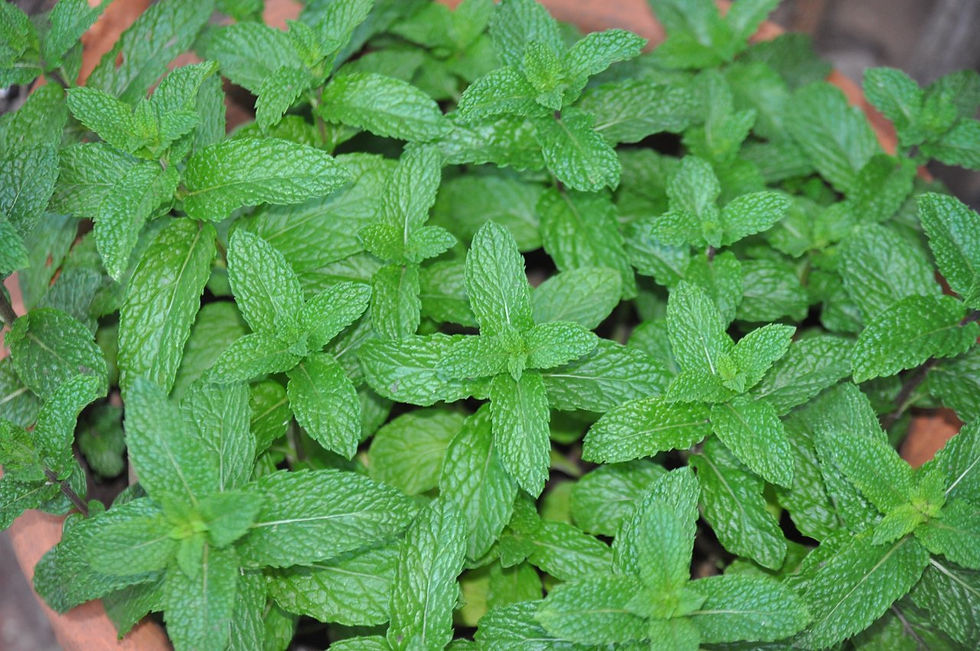Magical Mint
- Gerda Herenius

- Jan 28
- 8 min read
Updated: Feb 13
Mentha spp.

Introduction to Mentha spp.
Mints are hardy, summer-flowering, perennial herbs belonging to the genus Mentha spp. in the Lamiaceae family, which also includes other aromatic herbs like sage, oregano, basil, lavender and thyme.
What sets the Lamiaceae family of plants apart is their unique square stem structure. Their highly aromatic leaves grow in pairs squarely opposite each other, directly from the stem. Their tiny flowers are strongly scented and have a delicate, lipped appearance, like miniature mouths.
It is believed that mint is native to the Mediterranean basin. There are hundreds of varieties in the more or less 25 species in the Mentha genus. Mints can be divided into three main species: Mentha spicata (Spearmint), Mentha piperita (Peppermint) and Mentha pulegium (Pennyroyal). Spearmint is the species most widely used for cooking as it has a milder flavour and aroma than Peppermint. Mentha spicata and Mentha piperita are the two most well-known and widely commercially grown species. Mint varieties grown close together can easily cross-pollinate, giving rise to hundreds of mints, some even undocumented. Well-known varieties are Bergamot Mint, Orange Mint, Apple Mint, Chocolate Mint, Pineapple Mint, etc. Some mints are hybrids that do not flower, which means that they are sterile.
History of Mint
A story from Greek mythology tells us that mints were already in common use in Ancient Greece. Hades, the god of the underworld, seldom left his dominions to visit the upper world. Now and then, business or lust would motivate him to visit the upper realms. On one such occasion he met the Nymph Minthe and dazzled her with his golden chariot drawn by four black horses. Before he was able to successfully seduce Minthe, his wife, Queen Persephone, showed up and metamorphosed the poor nymph into a strong aromatic, ground-clinging plant.
The Romans continued this myth with Pluto as their version of Hades and the nymph, Mentha. Hence, the Latin name Mentha for this genus of plants. It is believed that the Romans introduced mint to the British Isles. It was presumably the early Pilgrim Fathers who brought mint to America. Today, it is one of the most common herbs used globally.
It was most likely the Crusaders who brought mint to Northern and Central Europe from the Holy Land. The New Testament’s Matthew 23:23 mentions that mint, along with anise and cumin, were used as tithes by the Pharisees.
Ancient Athenians perfumed their bodies with scented herbs; a different herb for each part of the body with mint designated to the arms. Greeks, as well as Romans, crowned themselves with peppermint. Their tables were adorned with mint sprays during feasts. According to Pliny the Elder, their sauces and wines were flavoured with this herb. Mint was used as a medicinal herb to treat stomach-ache, aid digestion and was used to freshen breath and whiten teeth.
Mint was grown in Convent Gardens in the ninth century. It is mentioned in a thirteenth century Icelandic Pharmacopoeia. As early as the fourteenth century, there are records of early versions of toothpaste. Geoffrey Chaucer of the famous Canterbury Tales, who lived from about 1340 to 1400, speaks of ‘a little path of mintes full and fenill greene’. Mayster Jon Gardener mentions ‘myntys’ in his Feate of Gardening which was published in 1440.
The Berber people who have inhabited the Maghreb—Algeria, Libya, Mauritania, Morocco and Tunisia—for thousands of years, drank a tisane by infusing mint leaves in hot water. The very profitable tea trade of the British Empire lost its central European markets after the start of the Crimean War. This forced British tea traders to look for markets elsewhere to sell their surplus tea. They discovered the Berbers in the Maghreb and persuaded them to add Chinese green teas—green gunpowder, oolong or jasmine teas—to their mint tisane. The suggestion was enthusiastically welcomed and the people of the Maghreb have been drinking mint tea, or Chai Bi Na’na as it is called in Morocco, ever since.
Medicinal Properties of Mint
The use of mint in herbal medicine has been around since ancient times. It is believed that mint is an antispasmodic, relieving disturbances of the digestive tract such as colic, nausea, stomach-ache, and flatulence by consuming it as a tisane, either hot or cold. Drinking a cup of mint tisane after meals, especially rich and heavy meals, aids digestion. Pour a cup of boiling water over a quarter cup of crushed mint leaves, add some honey or brown sugar and then let it steep for a few minutes. Strain the mint leaves from the tea before consuming. Mint tisane can also treat minor throat and mouth irritations. Chew a few fresh leaves to freshen the mouth and sweeten the breath.
Mint has analgesic and antipruritic properties. Used as external rubs, or added to bathwater, it relieves body fatigue, aches and pains, painful joints, or soothes rashes and itchy skin, whether from skin disorders or insect bites. Steep crushed mint leaves in apple cider vinegar and let it stand for 24 hours. Use this as a rub on painful areas or rub into the temples to relieve headaches. Dip a cloth in the apple cider vinegar-mint mixture and place it on your forehead to soothe a headache. Sweet almond oil can be used in lieu of apple cider vinegar. The cooling sensation provided by mint helps to treat sunburn.
Mint relieves sinusitis and congestion from colds and flu. Pour a litre of boiling water over a cup and a half of crushed mint leaves in a bowl. Throw a towel over your head and the bowl and breathe in the steam. South Africa’s own Tswana, Xhosa and Southern Sotho peoples use mint in traditional medicine by consuming a mint tisane for colds and coughs. The Sotho people place mint in their bedding and in pillows to ease breathing for sufferers of asthma and bronchitis.
Domestic Uses of Mint
Mint repels mosquitoes, ants, fleas, cockroaches, and flies. Keep pots of mint in the bedroom, kitchen, or on the patio. Hang fresh bunches of mint in the kitchen or the pantry. Bruise the leaves every so often and replace them once they have dried out. Rub fresh leaves, preferably peppermint, on your skin to repel mosquitoes. Scatter fresh or dried leaves around food to keep mice away. Put crushed mint in cupboards or in bedding to keep ants and fleas at bay. Add mint to potpourri sachets to freshen clothing and linen.
Please note that mint is toxic to animals if ingested!
Cosmetic Uses of Mint
The essential oil produced from the menthol in mint is very popular for use in aromatherapy, cosmetics and perfumes. The sweet and aromatic flavour of mint with its cool after-taste is a favourite to flavour anything from medicines like cough mixtures, toothpastes, mouthwashes/rinses, lip balms, chewing gum to sweets. Add some crushed mint leaves or a few drops of essential oil to hand cream for dry chapped hands.
Culinary Uses of Mint
Mint has been used in cooking for millennia: to garnish dishes, desserts and drinks, in salads, as a tisane or to flavour tea, mint jelly for your roast lamb, in dolmades, tabbouleh, fish or lamb dishes. And don’t forget those delicious Cuban mojitos on hot summer afternoons!

Always crush mint leaves to break down the tough cellular walls to release the natural oils and aroma. You can crush them between your fingers, with a rolling pin, or a muddler. Adding finely chopped leaves to peas, carrots or baby potatoes with melted butter can turn simple vegetables into a delicious side dish.
A mint harvest can be preserved by freezing the washed leaves in zip lock freezer bags or freezer containers. Leaves can be dried in the microwave or conventional oven. Crushed leaves can be frozen in ice cubes and added to iced tea or other drinks.
How to Grow Mint

Mint is a fast-growing plant with an aggressive spreading rhizome root system. If left to run amok, it can become a pest and take over your whole garden, throttling other plants. It is best to grow it in a pot or in an area in your garden where it will be contained. The plants will need repotting every 2 to 3 years as they very quickly become pot-bound.
If you have flowering mints, enjoy the flowers, but cut them back before they can seed. Cut taller stems back to prevent them from flopping over, reaching the ground, and taking root. Keep the pots in trays to stop the roots from escaping. You could plant them between pavers where it is bordered and contained by concrete. Some people allow it to grow into their lawns so that the glorious aroma is released when they mow the lawn. You could also put your container somewhere alongside a walkway where its soothing fragrance will be set free when it is brushed against.
Although mint can be harvested all year round it is a good idea, once a year, before or just after it has flowered, to cut it right back to about a third of its size. There is a multitude of uses for a large harvest. Aside from the tips given above, you can also strip the leaves from the cuttings and use them as mulch to help repel insects such as cabbage moth and carrot fly. Make sure there are no stems in your mulch, or they will quickly take root and grow!
Mint is easily propagated from young offshoots. These can be planted directly into the ground or kept in a glass of water until it has sprouted roots. The best time to plant new cuttings is in spring.
Mint likes full sun. However, in the ferocious African sun, it is better to plant it in an area where it gets morning sun. It does well in partial shade, especially in hot climates. It is a moisture-loving plant. Keep the soil slightly moist and make sure your pots have good drainage to keep them from becoming water-logged. Include mints in your fertilising schedule to keep them vigorous and healthy. Mint is a perennial and grows all year round but it might die back in winter in very cold areas with severe frost.
A hardy plant, mint is usually quite pest and disease resistant. The sharp smell of mint repels pests while attracting beneficial insects if it is a flowering mint. It is thus an excellent companion, along with marigold and oregano, for tomatoes, eggplants, carrots, celery, parsnips, parsley, kale, cauliflower, and cabbages.
Mint can however, become infested with Two-spotted spider mites, Tetranychus urticae, which can be combatted with an appropriate treatment. Although unusual, mints can also suffer from fungal diseases such as mint rust or leaf blight. There is no treatment for mint rust. These plants should rather be removed from the garden. The fungus will be present in the soil, so it is important to also treat the soil. Root rot is the result of bad drainage. It is best to remove the plant and the surrounding soil. Powdery mildew is usually the result of too much humidity and not enough sun. This can be treated with an appropriate fungicide or a solution of water and milk sprayed on the plants’ leaves at regular intervals until all signs of the fungus has disappeared.
Resources:
Roberts Margaret, Margaret Roberts’ Book of Herbs, Southern Book Publishers, Halfway House, 1993
Roberts, Margaret, Margaret Roberts’ A-Z of Herbs, Struik Publishers, Cape Town, 2000
Roberts, Margaret, Margaret Roberts Cooks with Herbs & Spices, Southern Book Publishers, Johannesburg, 1988



Comments